Key takeaways:
- Design critiques provide valuable insights that reveal overlooked strengths and weaknesses in work, fostering a growth mindset.
- Receiving and embracing feedback positively can enhance collaboration and lead to innovative design improvements.
- Preparing for critiques by stepping back and anticipating questions helps articulate design rationale and encourages constructive discussions.
- Documenting feedback transforms critiques into actionable insights, promoting continuous personal and design growth.
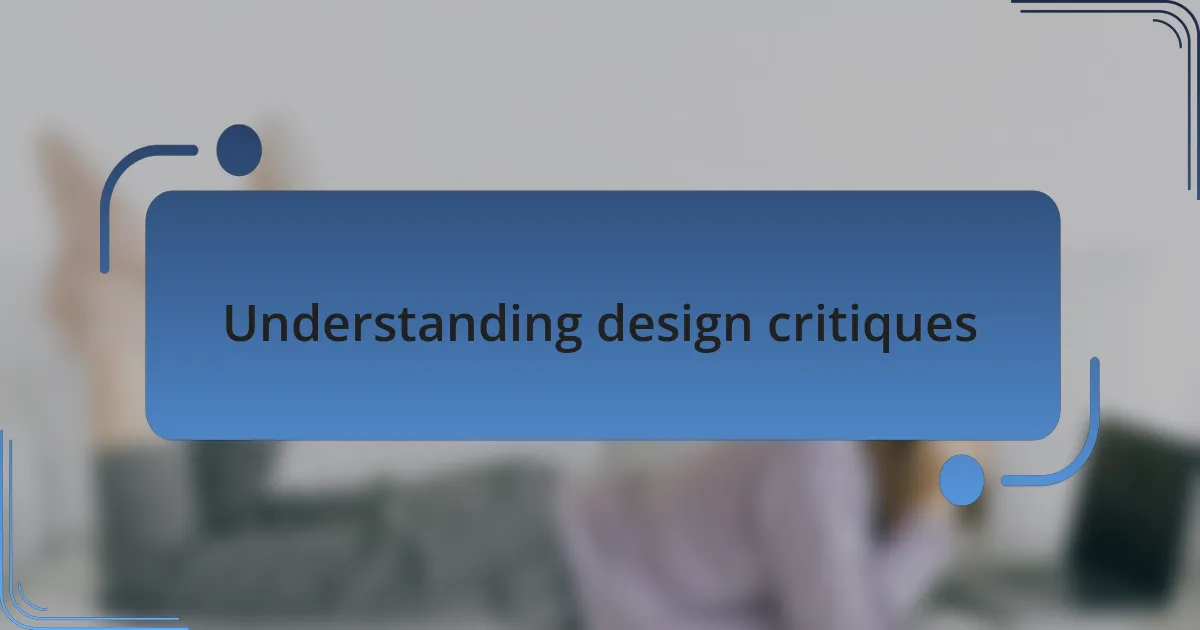
Understanding design critiques
Design critiques are an essential part of the creative process, allowing us to gain fresh perspectives on our work. I vividly recall a time when I presented a website I designed for a local business. The feedback wasn’t what I expected; some critiques felt harsh. However, I soon realized that those observations illuminated aspects of my design I had overlooked. Isn’t it fascinating how a new viewpoint can reveal strengths and weaknesses we might miss?
Think about it: what does it feel like to hear someone critique something you poured your heart into? Initially, it can sting, but I’ve learned to see this as a chance for growth. This mindset shift allows me to embrace feedback rather than fear it. It’s a dialogue, not a monologue, where every comment can spark significant improvements, sometimes leading to the best design decisions I’ve ever made.
Moreover, understanding that critiques come from a place of wanting to help can transform the way we receive them. I often remind myself that the feedback I get isn’t a judgment of my abilities, but rather a step toward creating a better product. That realization turned a challenging moment into an opportunity; it helped me hone my skills and take my designs to the next level. Isn’t that the ultimate goal for all of us in this field?
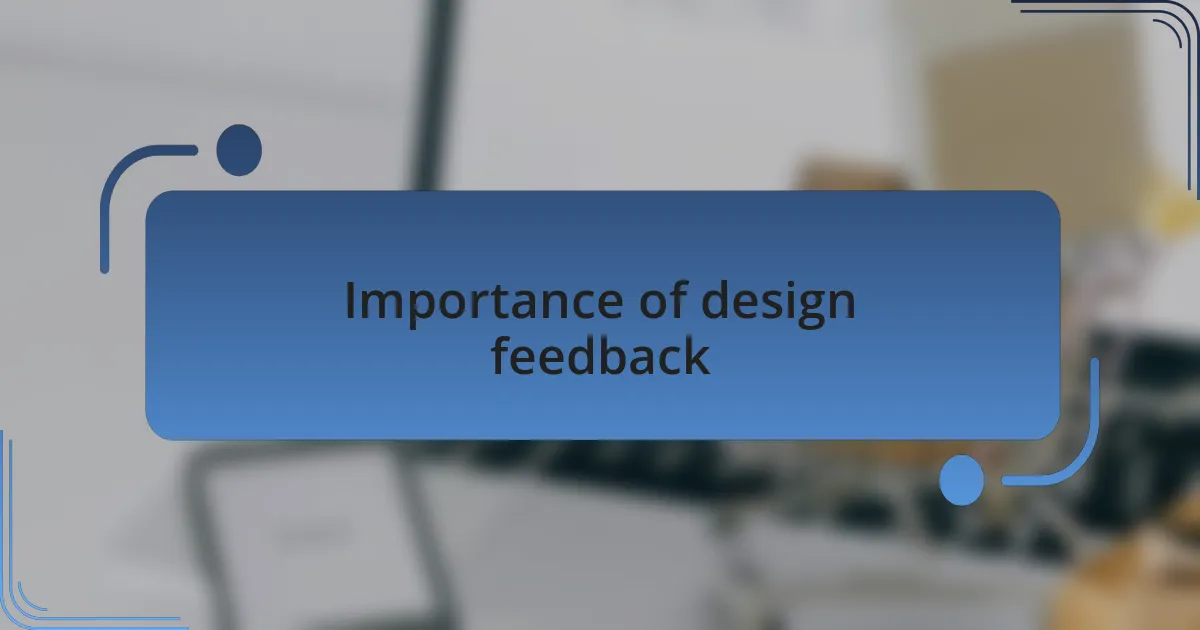
Importance of design feedback
Design feedback is like a mirror reflecting the hidden facets of our work. I remember presenting a project to my peers, only to be met with comments I initially found hard to digest. Yet, with time, I realized those critiques brought clarity to the muddled thoughts I had about my design choices. How could I have overlooked certain elements? It amazed me that others could see things I was too close to recognize.
Embracing feedback can be a challenge, but it holds incredible potential for growth. I once had a mentor who always said, “Every piece of feedback is a stepping stone.” I took this to heart after a client pointed out usability issues I hadn’t considered. That moment prompted me to rethink my design process entirely, leading to more user-centric solutions in my future projects. Isn’t it interesting how a few words can redirect our creative paths?
Furthermore, the importance of design feedback lies not only in improvement but also in fostering collaboration. When I engage with others to discuss my designs, I feel a sense of camaraderie where ideas flow freely. This collective brainstorming often leads to innovative concepts that I wouldn’t have arrived at alone. Don’t you agree that an open exchange of ideas enriches the design process and everyone involved?
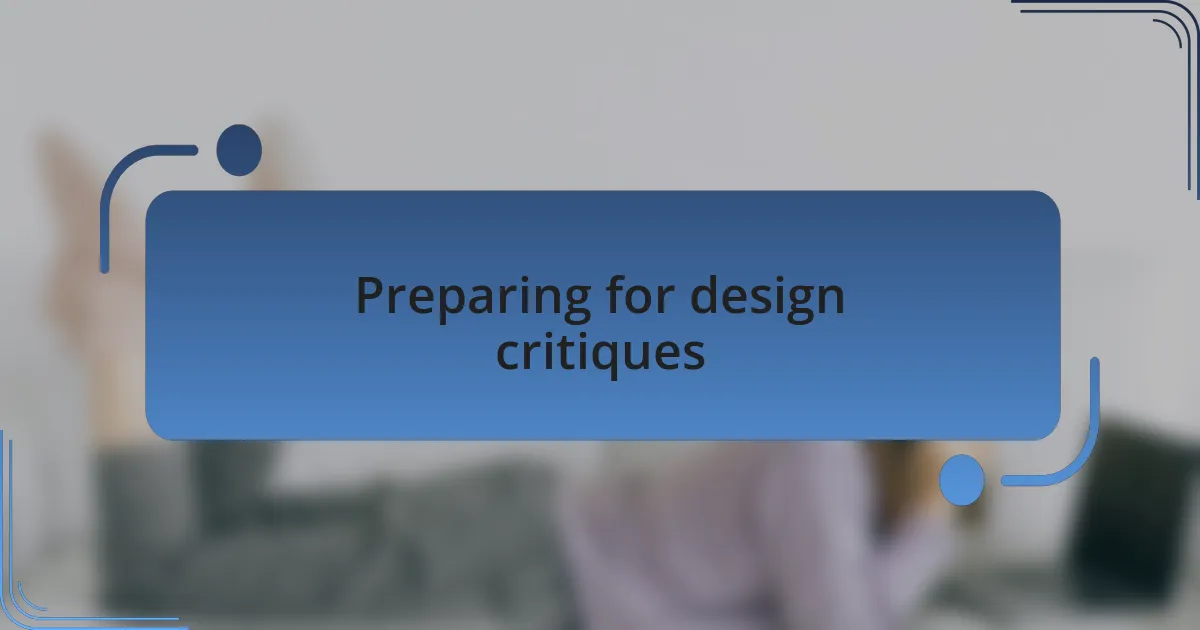
Preparing for design critiques
Preparing for design critiques requires a mix of mental and practical strategies. A few days before presenting my designs, I often take the time to step away from my work. This pause allows me to return with fresh eyes and a less emotional attachment, making it easier to hear feedback without getting defensive. Have you ever had an idea that felt perfect until someone else pointed something out? That’s the moment preparation becomes invaluable.
I also find it helpful to anticipate specific questions or comments that might arise during critiques. When I share my designs, I come equipped with the rationale behind my choices, which often sparks deeper conversations. For instance, during one session, I had to justify my color palette choice, and my thoughtful preparation allowed me to explain how it aligns with user experience principles. How empowering it is to articulate your design intentions clearly!
Lastly, creating an inviting atmosphere is crucial. I remember setting up a casual meeting space during a critique session, which eased the tension and encouraged openness. Providing snacks or a relaxed environment can shift the focus from judgment to genuine collaboration. Have you noticed how the right setting can influence the quality of feedback? When everyone feels comfortable, the insights shared become richer, fostering a creative dialogue that enhances the design process.
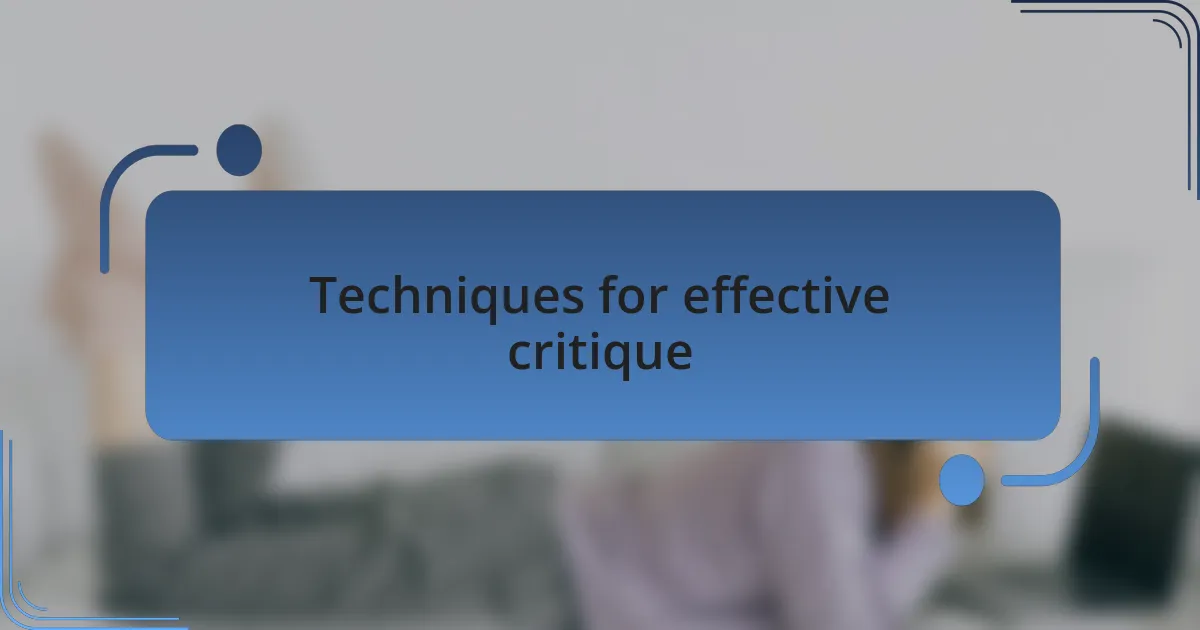
Techniques for effective critique
Engaging in effective critique requires a balance of openness and specificity. When I present my work, I invite feedback by asking targeted questions, such as, “What do you think about the navigation flow?” This approach not only guides reviewers but also shows that I’m genuinely interested in their opinions. Have you noticed how asking specific questions can lead to more constructive discussions instead of vague comments?
I also embrace the power of active listening during critique sessions. One memorable moment for me was when a colleague pointed out an inconsistency in my typography choices. Instead of immediately defending my decision, I paused and listened closely to their perspective. This not only highlighted areas for improvement but also taught me the value of considering different viewpoints. It’s fascinating how a single piece of feedback can drastically alter our design approach, don’t you think?
Lastly, documenting critique sessions has been invaluable. After discussions, I make it a point to jot down key insights and ideas that resonate with me. This practice creates a roadmap for my next design iteration and helps me track patterns in feedback over time. Have you ever realized that keeping notes can transform past critiques into a treasure trove of actionable insights? Each time I return to these notes, I see how much my designs have evolved.
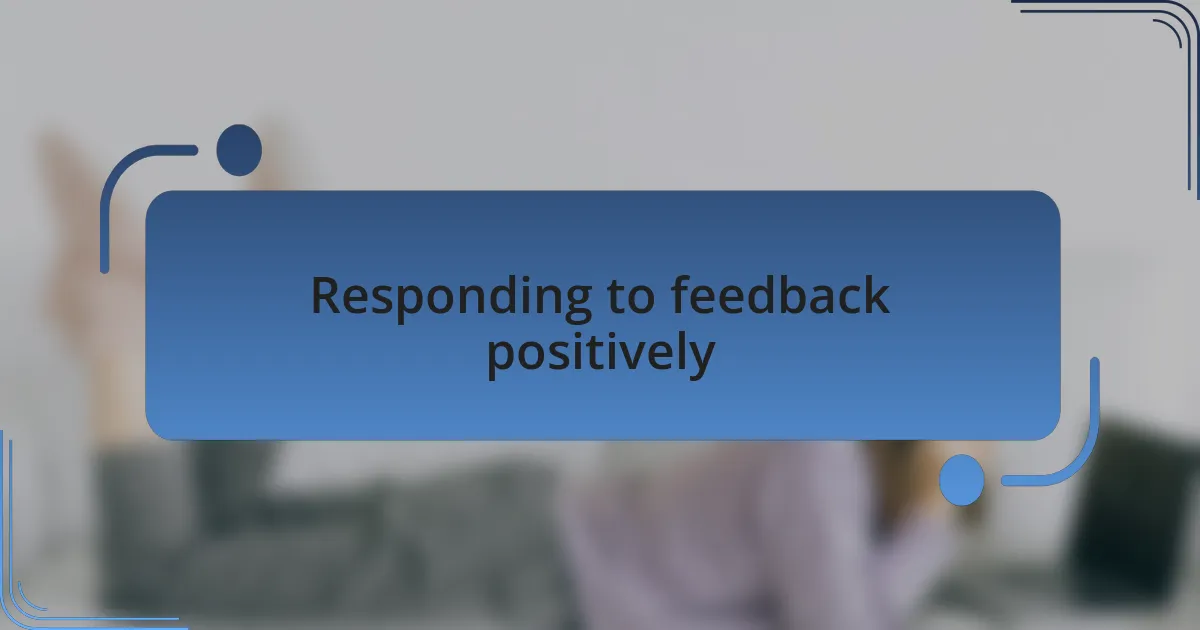
Responding to feedback positively
When receiving feedback, my initial reaction is to embrace it with a positive mindset. I recall a time when a client expressed reservations about the color palette I chose for their site. Rather than feeling defensive, I took a moment to appreciate their perspective. This shift in viewpoint allowed me to clarify my design choices and explore alternative options collaboratively, which ultimately strengthened our professional relationship. Isn’t it remarkable how a positive approach can turn a tense moment into a collaborative effort?
I also find that expressing gratitude for the feedback, regardless of how critical it may seem, sets a constructive tone. There was an instance where a mentor critiqued my layout by saying it felt cluttered. Instead of taking it to heart, I thanked them for their honesty, which opened the door for a richer dialogue about clarity and user experience. The emotional lift that comes from acknowledging feedback graciously can transform potential conflicts into opportunities for growth. Have you ever noticed how saying “thank you” can change the dynamics of a conversation?
Finally, I always try to follow up after a critique session to show that I value the input. This could be as simple as a quick message expressing how their feedback influenced my design revisions. Once, I implemented a suggestion from a colleague and messaged them to share the new iteration. Their excitement about seeing their ideas brought to life was contagious and reaffirmed the importance of positive engagement. Do you ever follow up on feedback? It can create lasting connections and foster a supportive design community.
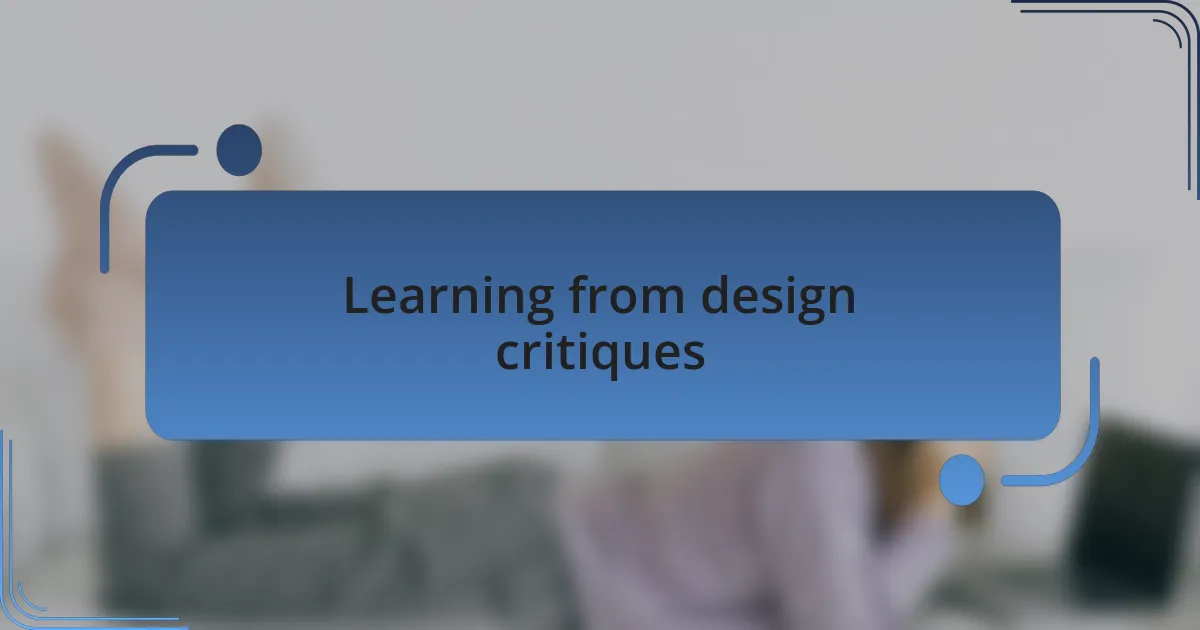
Learning from design critiques
Learning from critiques is a transformative experience for me. I remember a particular instance where I presented a prototype of a landing page, and the feedback was overwhelmingly critical. Instead of losing heart, I took a deep breath and listened intently. It struck me how each critique illuminated aspects of the design I had overlooked. Have you ever felt like feedback revealed a hidden truth about your work? It can be uncomfortable, but it often leads to breakthroughs that enhance my designs.
One of the lessons I’ve learned is to actively break down the feedback into actionable items. For example, after a collaborative session where various team members weighed in on my typography choices, I created a list of suggestions that resonated most. This process not only helped me prioritize my revisions but also allowed me to explore creative avenues I hadn’t considered before. Have you tried this approach? I find that it allows me to tackle critiques methodically while keeping my creative spirit intact.
I’ve also discovered that reflecting on critiques fosters personal growth beyond just design skills. After receiving some tough love about my interface navigation, I found myself contemplating the balance between creativity and functionality. It forced me to reevaluate what I define as “good design.” Some might see this as a setback, but I see it as an opportunity to deepen my understanding of user-centric design. How do you perceive criticism? If we can view it as a pathway to personal evolution, I believe we can harness its power more effectively.
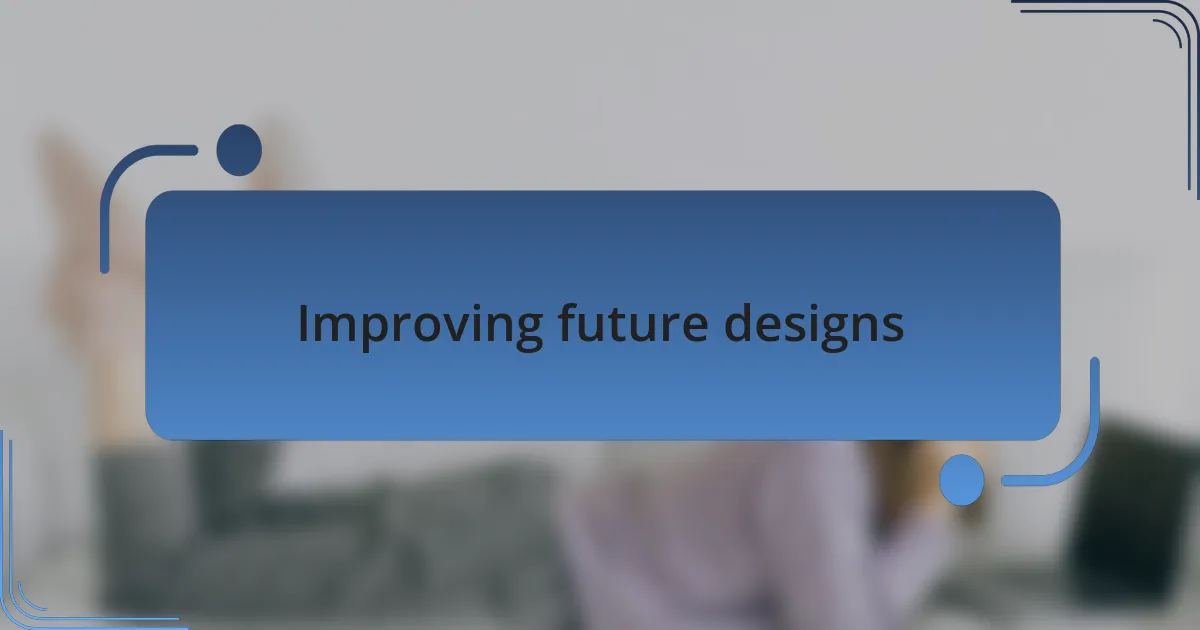
Improving future designs
Improving future designs often starts with a reflection on the lessons learned from previous critiques. For instance, after my last project, I realized how vital it is to ask clarifying questions. During the feedback session, one colleague pointed out that my color palette was confusing for users with visual impairments. This observation inspired me to dive deeper into accessibility standards. Have you ever considered how your design choices might affect different user groups? Recognizing these nuances pushes me to refine my aesthetic sensibilities in ways I hadn’t prioritized before.
Another key aspect of improvement lies in collaboration. In one project, I decided to involve more team members in the early design stages. Their diverse perspectives led to innovative solutions I would have otherwise missed. This experience taught me that inviting critiques early on can create a sense of community around the design process. Have you found that feedback is more productive when it’s sought out rather than received passively? I believe that preemptively involving others removes the stigma from critique and fosters a collaborative spirit.
Finally, I’ve learned that staying open-minded is crucial for continuous growth. I distinctly remember a time when I hesitated to incorporate certain suggestions because they seemed too far from my original vision. Yet, after some contemplation, I realized those suggestions could elevate the design to new heights. How often do we cling to our initial ideas, even when the feedback suggests better paths? By embracing a more flexible mindset, I can create work that resonates with users and reflects a more comprehensive understanding of their needs.